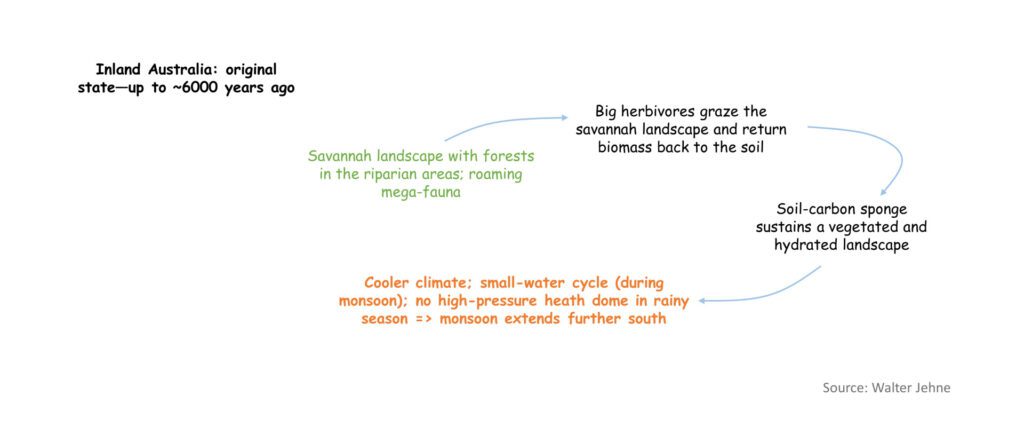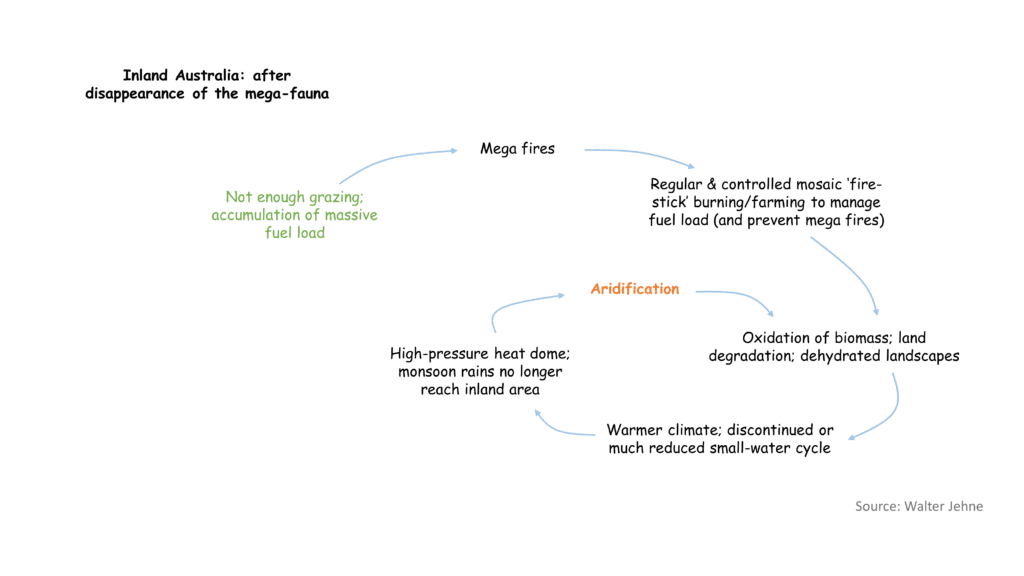In my previous post, I discussed a webinar by Walter Jehne “Restoring the water cycle to cool the climate”. One of the mechanisms he describes is the ‘biotic pump effect’.
Regarding this subject, Jehne makes an interesting statement at 1:15:10. He asserts that drying out of the landscape in northern inland Australian started with the disappearance of the large herbivores around 6000-8000 years ago. This mechanism is illustrated below in two simple schematics. The end state is a dehydrated landscape that creates a high-pressure dome that prevents moist marine monsoon air from flowing into inland areas and thus perpetuates aridification.
Jehne cautions that this theory is still somewhat contentious—since we were not there at that time—but also thinks that it is entirely plausible.


A variation of the mechanism described above is at the core of Allan Savory’s plant-stimulating grazing system, which he coined ‘holistic (grazing) management’. It employs the same premise: to maintain and build soils, biomass must be biologically decomposed rather than oxidized or burned. In dry areas—where there is not enough soil moisture to sustain the microorganisms that are a key element of the soil-food web necessary for biodegradation—decomposition must be done by grazers. At the same time, however, over-grazing and selective grazing must be prevented, as denuded landscapes also accelerate land degradation. It is achieved by mimicking a grazing system characterized by fast-moving herds chased by large predators. In Savory’s grazing system, animals are therefore concentrated and moved every few days, after which the grassland gets ample time to recover (the maximum number of days they can stay on the same patch of land depends on the prevailing climate and soils). This approach builds the soil-carbon sponge and ensures that scarce rainfall is transpired (with biomass production) rather than evaporated (without any productive use).
Dehydrated landscapes with all attendant features (hotter, longer dry season, oxidation of biomass, accelerated soil degradation, erosion, weaker small-water cycle, incised streams, high pressure heat dome, etc.) have become a rather common occurrence—unfortunately—in many places. Examples are Amazonia (see Guardian article below) and a region around Masaka in Uganda that I know quite well, to mention just a few.
The above conceptual analysis provides a blueprint for land restoration and rehydration.
Jehne suggests a set of measures to restore 300 million hectares in northern inland Australia. The approach comprises wildfire repression in combination with plant-stimulating grazing practices to restore vegetation cover and rebuild the soil-carbon sponge, in-stream infrastructure in gullies and streams to slow down flood flows and rebuild floodplains, shelter woods, etc. He asserts that some positive impacts of such land restoration efforts should be visible within 3-5 years.
Nature has all these solutions; it has worked those out over billions of years; we just gotta be smart, less arrogant, and listen to her (Walter Jehne @ 1:36:48)

In Aboriginal tradition, the rainbow serpent is associated with rain and (soil) fertility. The rainbow serpent effectively represents the fickle monsoon that brings prosperity but when disturbed can also bring chaos (from Wikipedia). I fear it’s thoroughly disturbed right now….
Jimi Sol—as so often—has created a beautiful animation to explain the biotic pump.
Well, maybe Jehne is right, after all. See the below article in the Guardian; the similarities with what happened in northern inland Australia some 6000 years ago are eerie.
Of course, there are differences as well. In Amazonia, the soil-carbon sponge is destroyed by (deliberate) forest clearing. In northern inland Australia, the root cause for aridification was probably controlled (and deliberate) grassland burning—the firestick method. Nevertheless, the same mechanism—a heat dome that lessens/prevents the inflow of moist marine monsoon air & a weaker small water cycle—is at play. It’s quite ominous.
The above video presents some successful examples of regenerative agriculture.
